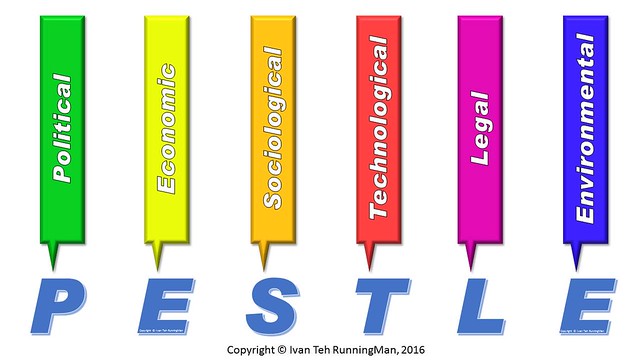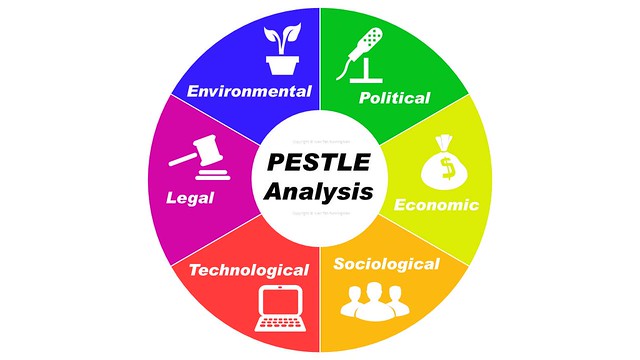PESTLE Analysis
Written & Researched by: Ivan Teh RunningMan
The PESTLE Analysis is a framework used by organisations for strategic decision making. It describes a set of macro-environment factors which may potentially affect how a business operates. The PESTLE Analysis is used by Marketing departments for market research and market analysis.
 |
| PESTLE Analysis |
The PESTLE Analysis, which is an expansion of the basic PEST Analysis, is an acronym which stands for: Political, Economic, Sociological, Technological, Legal, and Environmental. By understanding these 6 factors, an organisation will be better positioned to react and respond to changes, being nimble enough to capitalise on opportunities, while mitigating risks.
Definition Of PESTLE:
- Political: Refers to the degree of government intervention. Examples include taxes & tariffs, business autonomy, trade restrictions, national infrastructure, corruption, and political stability.
- Economic: Refers to factors affecting day-to-day operating decisions. Examples include inflation / deflation, levels of employment / unemployment, cost of raw materials & labour, cost of living, exchange rates, interest rates, and credit availability.
- Sociological: Refers to the culture and norms of the society in which the business operates. Examples include cultural beliefs & practices, demographics, psychographics, affluence / lifestyle, population growth rates, and consumer spending patterns.
- Technological: Refers to the rate of adoption of new inventions, innovations, or developments. Examples include advancements in digital / internet related areas, spending on research & development, changes in manufacturing methods & distribution channels, automation, outsourcing / insourcing, and lowering of barriers to entry.
- Legal: Refers to international and local laws or regulations which must be complied with. Examples include employment laws, advertising laws, consumer protection, business regulations, lawsuit procedures, health & safety laws, environmental regulations, and anti-discrimination laws.
- Environmental: Refers to factors that influence or are determined by the surrounding environment. Examples include utilisation of natural resources, animal rights, waste disposal, weather / climate, geographical location, and preservation.
Increasingly, some have expanded on the the PESTLE Analysis, changing it to STEEPLE Analysis. The additional 'E' here is Ethics, which refers to moral principles guiding how to act rightly or justly. Examples include corporate social responsibility, moral dilemmas, fair trade, affiliations between organisations and charities, and integrity in business dealings with others.
Application Of PESTLE:
The PESTLE Analysis can be performed for the whole organisation, or even just a single department. It can be used in situations such as strategic planning, marketing campaign development, managing organisational change, business / product development, or for research.
Prior to beginning the PESTLE Analysis, appropriate sources of information should be identified, and collected. The findings should then be analysed, preferably by a team of people, as multiple perspectives and viewpoints will strengthen the result. Finally, an action plan should be developed based on the findings.
 |
| PESTLE Analysis |
Limitations Of PESTLE:
With the PESTLE Analysis, there is a tendency to get bogged down by the vast amount of data, or the tendency to oversimply the data. Access to accurate, quality data may also be time-consuming and expensive. And with the rapid pace of change in today's world, it can be difficult to anticipate future developments.
Thus, while the PESTLE Analysis is useful, it is also best used in conjunction / combined with data from other analysis tools, such as a SWOT Analysis. The PESTLE Analysis should also be performed on a regular basis, and incorporated as part of an ongoing process to monitor changes in the business macro-environment.
.....
Source Attributions:
Mike Morrison & Kathy Daniels, "CIPD - PESTLE Analysis", published by Chartered Institute of Personnel and Development (CIPD), November 2010. Retrieved 02 May 2016, from https://www.heftfaculty.co.uk/content/how-guides-tools.
Alan Chapman, "PEST Market Analysis Tool", published and hosted by Businessballs.com, August 2005. Retrieved 02 May 2016, from http://www.businessballs.com/pestanalysisfreetemplate.htm.
Jim Makos, "Difference Between STEEP And STEEPLE Analysis", published and hosted by PESTLE Analysis, March 2015. Retrieved 02 May 2016, from http://pestleanalysis.com/steep-and-steeple-analysis/.
.....


CONVERSATION